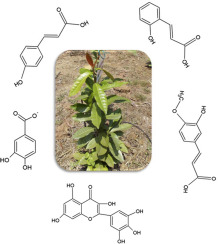当前位置:
X-MOL 学术
›
Int. J. Mass Spectrom.
›
论文详情
Our official English website, www.x-mol.net, welcomes your feedback! (Note: you will need to create a separate account there.)
Identification and quantification of cytotoxic phenolic acids and flavonoids in Ixora brachiata by UHPLC-DAD and UHPLC-ESI-MS/MS
International Journal of Mass Spectrometry ( IF 1.8 ) Pub Date : 2020-04-01 , DOI: 10.1016/j.ijms.2020.116290 N. Bhagya , K.R. Chandrashekar
International Journal of Mass Spectrometry ( IF 1.8 ) Pub Date : 2020-04-01 , DOI: 10.1016/j.ijms.2020.116290 N. Bhagya , K.R. Chandrashekar

|
Abstract Ixora brachiata a plant with ethnomedicinal value is used in the treatment of skin diseases. The present study was carried out to evaluate the cytotoxic effect of methanolic extract of I. brachiata leaf samples against human breast (MDA-MB-231) and pancreatic (PANC-1) cancer cell lines. An attempt was also made to identify and quantify the phenolic acids and flavonoids using ultra high performance liquid chromatography (UHPLC) – diode array detector (DAD) coupled with electrospray ionization mass spectroscopy (UHPLC-ESI-MS/MS). The study revealed dose dependant cytotoxicity with 50% inhibitory (IC50) effect of I. brachiata at a concentration of 115.77 and 80 μg/ml against MDA-MB-231 and PANC-1 cells respectively. The IC50 value of cisplatin was recorded at a concentration of 19.76 and 6.22 μg/ml against MDA-MB-231 and PANC-1 cells respectively. UHPLC-DAD and UHPLC-ESI-MS/MS analysis showed the presence of 13 phenolic acids and 10 flavonoids. Quantitative determination of the compounds revealed the presence of significantly high quantity of protocatechuic acid (20.19 ± 0.17 mg/g) with a total yield of 58.55 ± 0.9 mg/g of phenolics. Similarly, a significantly high quantity of myrcetin (5.03 ± 0.02 mg/g) was detected as a major flavonoid out of the total yield of 5.17 ± 0.02 mg/g. The presence of phenolic acids and flavonoids in the leaf methanol extract of I. brachiata might have contributed towards the cytotoxic effect of this plant. However, further investigations are warranted to confirm the specific phenolic acid/flavonoid responsible for the cytotoxic effect of this plant.
中文翻译:

使用 UHPLC-DAD 和 UHPLC-ESI-MS/MS 鉴定和定量 Ixora brachiata 中的细胞毒性酚酸和黄酮类化合物
摘要 Ixora brachiata 是一种具有民族药用价值的植物,用于治疗皮肤病。本研究旨在评估 I. brachiata 叶样品的甲醇提取物对人乳腺癌 (MDA-MB-231) 和胰腺 (PANC-1) 癌细胞系的细胞毒性作用。还尝试使用超高效液相色谱 (UHPLC) - 二极管阵列检测器 (DAD) 结合电喷雾电离质谱 (UHPLC-ESI-MS/MS) 来鉴定和量化酚酸和黄酮类化合物。该研究揭示了浓度为 115.77 和 80 μg/ml 的 I. brachiata 对 MDA-MB-231 和 PANC-1 细胞的剂量依赖性细胞毒性和 50% 抑制 (IC50) 效应。在浓度为 19.76 和 6 时记录了顺铂的 IC50 值。22 μg/ml 分别针对 MDA-MB-231 和 PANC-1 细胞。UHPLC-DAD 和 UHPLC-ESI-MS/MS 分析显示存在 13 种酚酸和 10 种黄酮类化合物。化合物的定量测定显示存在显着大量的原儿茶酸 (20.19 ± 0.17 mg/g),酚类物质的总产量为 58.55 ± 0.9 mg/g。同样,在 5.17 ± 0.02 mg/g 的总产量中,检测到大量的杨梅素(5.03 ± 0.02 mg/g)作为主要黄酮类化合物。I. brachiata 叶甲醇提取物中酚酸和黄酮类化合物的存在可能有助于该植物的细胞毒性作用。然而,有必要进行进一步的调查以确认导致该植物细胞毒性作用的特定酚酸/类黄酮。UHPLC-DAD 和 UHPLC-ESI-MS/MS 分析显示存在 13 种酚酸和 10 种黄酮类化合物。化合物的定量测定表明存在大量原儿茶酸 (20.19 ± 0.17 mg/g),酚类物质的总产量为 58.55 ± 0.9 mg/g。同样,在 5.17 ± 0.02 mg/g 的总产量中,检测到大量的杨梅素(5.03 ± 0.02 mg/g)作为主要黄酮类化合物。I. brachiata 叶甲醇提取物中酚酸和黄酮类化合物的存在可能有助于该植物的细胞毒性作用。然而,有必要进行进一步的研究以确认导致该植物细胞毒性作用的特定酚酸/类黄酮。UHPLC-DAD 和 UHPLC-ESI-MS/MS 分析显示存在 13 种酚酸和 10 种黄酮类化合物。化合物的定量测定显示存在显着大量的原儿茶酸 (20.19 ± 0.17 mg/g),酚类物质的总产量为 58.55 ± 0.9 mg/g。同样,在 5.17 ± 0.02 mg/g 的总产量中,检测到大量的杨梅素(5.03 ± 0.02 mg/g)作为主要黄酮类化合物。I. brachiata 叶甲醇提取物中酚酸和黄酮类化合物的存在可能有助于该植物的细胞毒性作用。然而,有必要进行进一步的研究以确认导致该植物细胞毒性作用的特定酚酸/类黄酮。化合物的定量测定显示存在显着大量的原儿茶酸 (20.19 ± 0.17 mg/g),酚类物质的总产量为 58.55 ± 0.9 mg/g。同样,在 5.17 ± 0.02 mg/g 的总产量中,检测到大量的杨梅素(5.03 ± 0.02 mg/g)作为主要黄酮类化合物。I. brachiata 叶甲醇提取物中酚酸和黄酮类化合物的存在可能有助于该植物的细胞毒性作用。然而,有必要进行进一步的调查以确认导致该植物细胞毒性作用的特定酚酸/类黄酮。化合物的定量测定表明存在大量原儿茶酸 (20.19 ± 0.17 mg/g),酚类物质的总产量为 58.55 ± 0.9 mg/g。同样,在 5.17 ± 0.02 mg/g 的总产量中,检测到大量的杨梅素(5.03 ± 0.02 mg/g)作为主要黄酮类化合物。I. brachiata 叶甲醇提取物中酚酸和黄酮类化合物的存在可能有助于该植物的细胞毒性作用。然而,有必要进行进一步的研究以确认导致该植物细胞毒性作用的特定酚酸/类黄酮。02 mg/g) 被检测为总产量 5.17 ± 0.02 mg/g 中的主要黄酮类化合物。I. brachiata 叶甲醇提取物中酚酸和黄酮类化合物的存在可能有助于该植物的细胞毒性作用。然而,有必要进行进一步的研究以确认导致该植物细胞毒性作用的特定酚酸/类黄酮。02 mg/g) 被检测为总产量 5.17 ± 0.02 mg/g 中的主要黄酮类化合物。I. brachiata 叶甲醇提取物中酚酸和黄酮类化合物的存在可能有助于该植物的细胞毒性作用。然而,有必要进行进一步的研究以确认导致该植物细胞毒性作用的特定酚酸/类黄酮。
更新日期:2020-04-01
中文翻译:

使用 UHPLC-DAD 和 UHPLC-ESI-MS/MS 鉴定和定量 Ixora brachiata 中的细胞毒性酚酸和黄酮类化合物
摘要 Ixora brachiata 是一种具有民族药用价值的植物,用于治疗皮肤病。本研究旨在评估 I. brachiata 叶样品的甲醇提取物对人乳腺癌 (MDA-MB-231) 和胰腺 (PANC-1) 癌细胞系的细胞毒性作用。还尝试使用超高效液相色谱 (UHPLC) - 二极管阵列检测器 (DAD) 结合电喷雾电离质谱 (UHPLC-ESI-MS/MS) 来鉴定和量化酚酸和黄酮类化合物。该研究揭示了浓度为 115.77 和 80 μg/ml 的 I. brachiata 对 MDA-MB-231 和 PANC-1 细胞的剂量依赖性细胞毒性和 50% 抑制 (IC50) 效应。在浓度为 19.76 和 6 时记录了顺铂的 IC50 值。22 μg/ml 分别针对 MDA-MB-231 和 PANC-1 细胞。UHPLC-DAD 和 UHPLC-ESI-MS/MS 分析显示存在 13 种酚酸和 10 种黄酮类化合物。化合物的定量测定显示存在显着大量的原儿茶酸 (20.19 ± 0.17 mg/g),酚类物质的总产量为 58.55 ± 0.9 mg/g。同样,在 5.17 ± 0.02 mg/g 的总产量中,检测到大量的杨梅素(5.03 ± 0.02 mg/g)作为主要黄酮类化合物。I. brachiata 叶甲醇提取物中酚酸和黄酮类化合物的存在可能有助于该植物的细胞毒性作用。然而,有必要进行进一步的调查以确认导致该植物细胞毒性作用的特定酚酸/类黄酮。UHPLC-DAD 和 UHPLC-ESI-MS/MS 分析显示存在 13 种酚酸和 10 种黄酮类化合物。化合物的定量测定表明存在大量原儿茶酸 (20.19 ± 0.17 mg/g),酚类物质的总产量为 58.55 ± 0.9 mg/g。同样,在 5.17 ± 0.02 mg/g 的总产量中,检测到大量的杨梅素(5.03 ± 0.02 mg/g)作为主要黄酮类化合物。I. brachiata 叶甲醇提取物中酚酸和黄酮类化合物的存在可能有助于该植物的细胞毒性作用。然而,有必要进行进一步的研究以确认导致该植物细胞毒性作用的特定酚酸/类黄酮。UHPLC-DAD 和 UHPLC-ESI-MS/MS 分析显示存在 13 种酚酸和 10 种黄酮类化合物。化合物的定量测定显示存在显着大量的原儿茶酸 (20.19 ± 0.17 mg/g),酚类物质的总产量为 58.55 ± 0.9 mg/g。同样,在 5.17 ± 0.02 mg/g 的总产量中,检测到大量的杨梅素(5.03 ± 0.02 mg/g)作为主要黄酮类化合物。I. brachiata 叶甲醇提取物中酚酸和黄酮类化合物的存在可能有助于该植物的细胞毒性作用。然而,有必要进行进一步的研究以确认导致该植物细胞毒性作用的特定酚酸/类黄酮。化合物的定量测定显示存在显着大量的原儿茶酸 (20.19 ± 0.17 mg/g),酚类物质的总产量为 58.55 ± 0.9 mg/g。同样,在 5.17 ± 0.02 mg/g 的总产量中,检测到大量的杨梅素(5.03 ± 0.02 mg/g)作为主要黄酮类化合物。I. brachiata 叶甲醇提取物中酚酸和黄酮类化合物的存在可能有助于该植物的细胞毒性作用。然而,有必要进行进一步的调查以确认导致该植物细胞毒性作用的特定酚酸/类黄酮。化合物的定量测定表明存在大量原儿茶酸 (20.19 ± 0.17 mg/g),酚类物质的总产量为 58.55 ± 0.9 mg/g。同样,在 5.17 ± 0.02 mg/g 的总产量中,检测到大量的杨梅素(5.03 ± 0.02 mg/g)作为主要黄酮类化合物。I. brachiata 叶甲醇提取物中酚酸和黄酮类化合物的存在可能有助于该植物的细胞毒性作用。然而,有必要进行进一步的研究以确认导致该植物细胞毒性作用的特定酚酸/类黄酮。02 mg/g) 被检测为总产量 5.17 ± 0.02 mg/g 中的主要黄酮类化合物。I. brachiata 叶甲醇提取物中酚酸和黄酮类化合物的存在可能有助于该植物的细胞毒性作用。然而,有必要进行进一步的研究以确认导致该植物细胞毒性作用的特定酚酸/类黄酮。02 mg/g) 被检测为总产量 5.17 ± 0.02 mg/g 中的主要黄酮类化合物。I. brachiata 叶甲醇提取物中酚酸和黄酮类化合物的存在可能有助于该植物的细胞毒性作用。然而,有必要进行进一步的研究以确认导致该植物细胞毒性作用的特定酚酸/类黄酮。



























 京公网安备 11010802027423号
京公网安备 11010802027423号